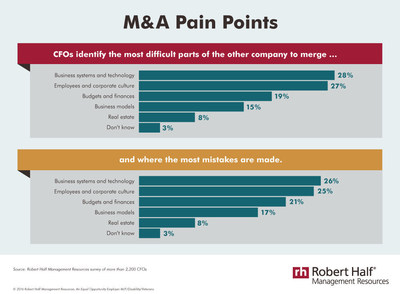Press Releases
Read about our latest research, including results from our ongoing surveys of senior managers and workers, and company announcements.
MENLO PARK, Calif., Nov. 15, 2016 -- The greatest pain points for companies going through a merger or acquisition are meshing technology and staff, recent research shows. In the Robert Half Management Resources survey, CFOs report business systems and employees and corporate culture are the hardest parts of an integration and where the most mistakes are made.

View an infographic with the survey results.
CFOs were asked, "In a merger or acquisition, which part of the other company is most difficult to integrate?" Their responses:
|
Business systems and technology |
28% |
|
Employees and corporate culture |
27% |
|
Budgets and finances |
19% |
|
Business models |
15% |
|
Real estate |
8% |
|
Don't know |
3% |
|
100% |
CFOs also were asked, "In a merger or acquisition, in which area of the integration do companies make the most mistakes?" Their responses:
|
Business systems and technology |
26% |
|
Employees and corporate culture |
25% |
|
Budgets and finances |
21% |
|
Business models |
17% |
|
Real estate |
8% |
|
Don't know |
3% |
|
100% |
"The time, complexity and layers involved in mergers and acquisitions are often more intense and cumbersome than anticipated," said Tim Hird, executive director of Robert Half Management Resources. "Integrating business systems, for example, will not only affect technology platforms but also compliance, internal controls, payroll and risk management. Preparing for issues well in advance can ease the transition."
Hird noted that as much as companies need to focus on the nuts and bolts of the transaction, they cannot emphasize these areas at the expense of the people affected. "Employees' anxiety immediately spikes following news of a corporate merger," he said. "Managers need to keep team members apprised of new developments and provide reassurance where they can."
Robert Half Management Resources highlights the following seven tips to help managers whose companies are going through the M&A process:
- Give yourself a head start. The need for due diligence extends from the organizational to the managerial level. Identify skills gaps and technical issues to be addressed, such as challenges integrating financial systems and complying with regulatory mandates.
- Create a unique workplace culture. Rather than forcing staff to adopt the values, beliefs and attitudes of one organization, establish a new vision everyone can get behind. Determine the steps needed to realize the goal, including how to communicate it to employees.
- Make integration efforts an ongoing priority. Ups and downs are inevitable as two organizations become one, and change management must be a central focus. Conduct regular check-ins with staff throughout the transition and beyond to ensure processes, teams and goals are aligned.
- Invest in professional development. Training on new business systems and processes should be a given, but also provide support in areas such as communication, adapting to change and teambuilding. These offerings can help teams get in sync and focus on common goals.
- Maintain communication. Stay attuned to employees' workloads and concerns. Anticipate their stressors, and look for ways to help them navigate the transition. You may not be able to give them any guarantees, but staff should feel confident that you support them and will be a more reliable source of information than the rumor mill.
- Tap all available internal resources. CFOs increasingly are partnering with their chief information officer and working with human resources. Emphasize the need for this type of cross-functional collaboration during a merger. Your transition team should include colleagues from across the organization.
- Bring in outside help. Companies rarely have all the merger expertise they need in-house. Work with experienced consultants who can help your firm navigate the transaction and ensure compliance with regulatory demands. Interim professionals can also step in to bridge skills gaps and handle projects for staff members who shift their focus to the merger.
About the Research
The survey was developed by Robert Half Management Resources and conducted by an independent research firm. It is based on telephone interviews with more than 2,200 CFOs from a stratified random sample of companies in more than 20 of the largest U.S. metropolitan areas.
About Robert Half Management Resources
Robert Half Management Resources is the premier provider of senior-level finance, accounting and business systems professionals to supplement companies' project and interim staffing needs. The company has more than 140 locations worldwide and offers assistance to business leaders and consultants at roberthalf.com/management-resources and on its blog at roberthalf.com/management-resources/blog.
SOURCE Robert Half Management Resources